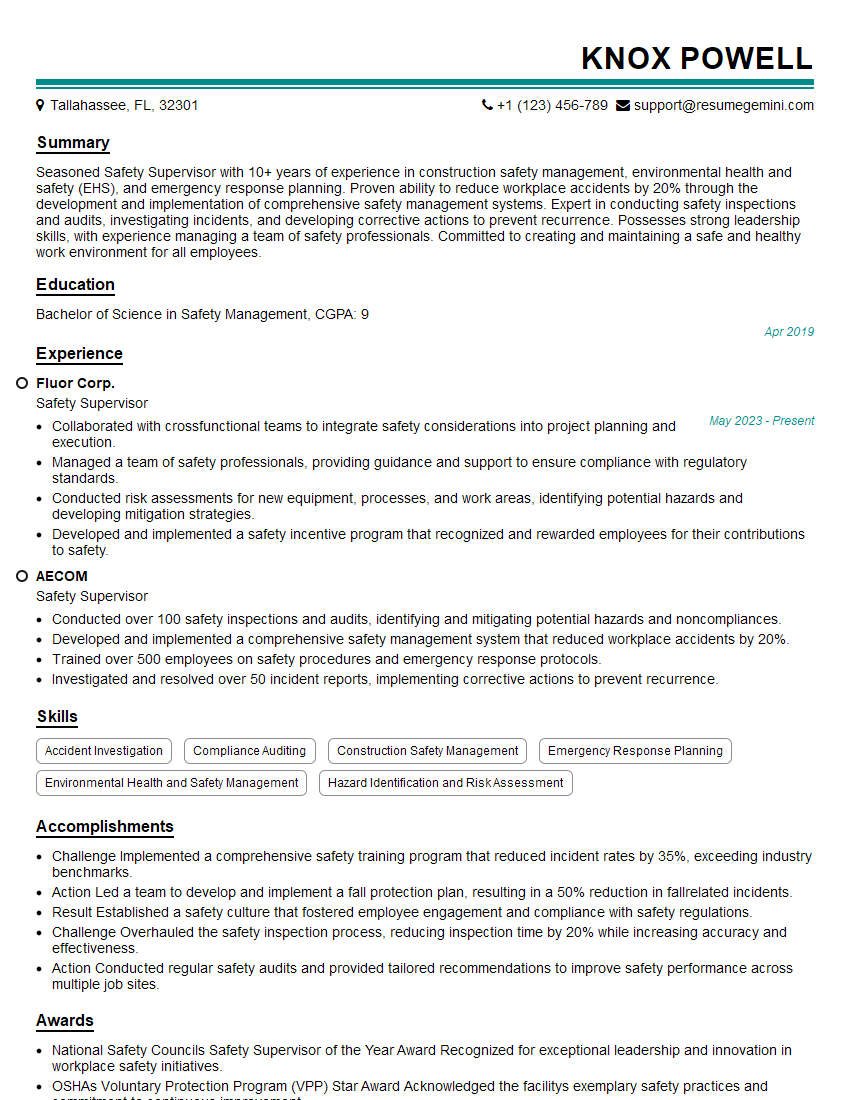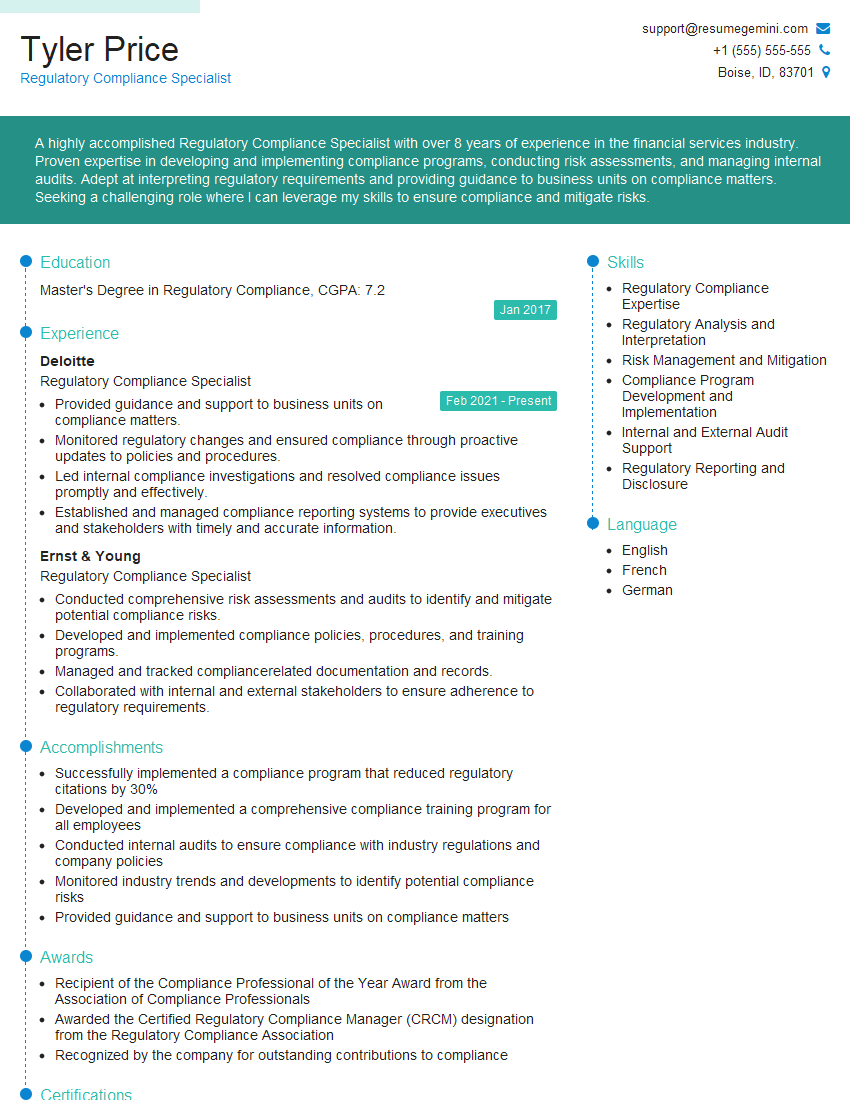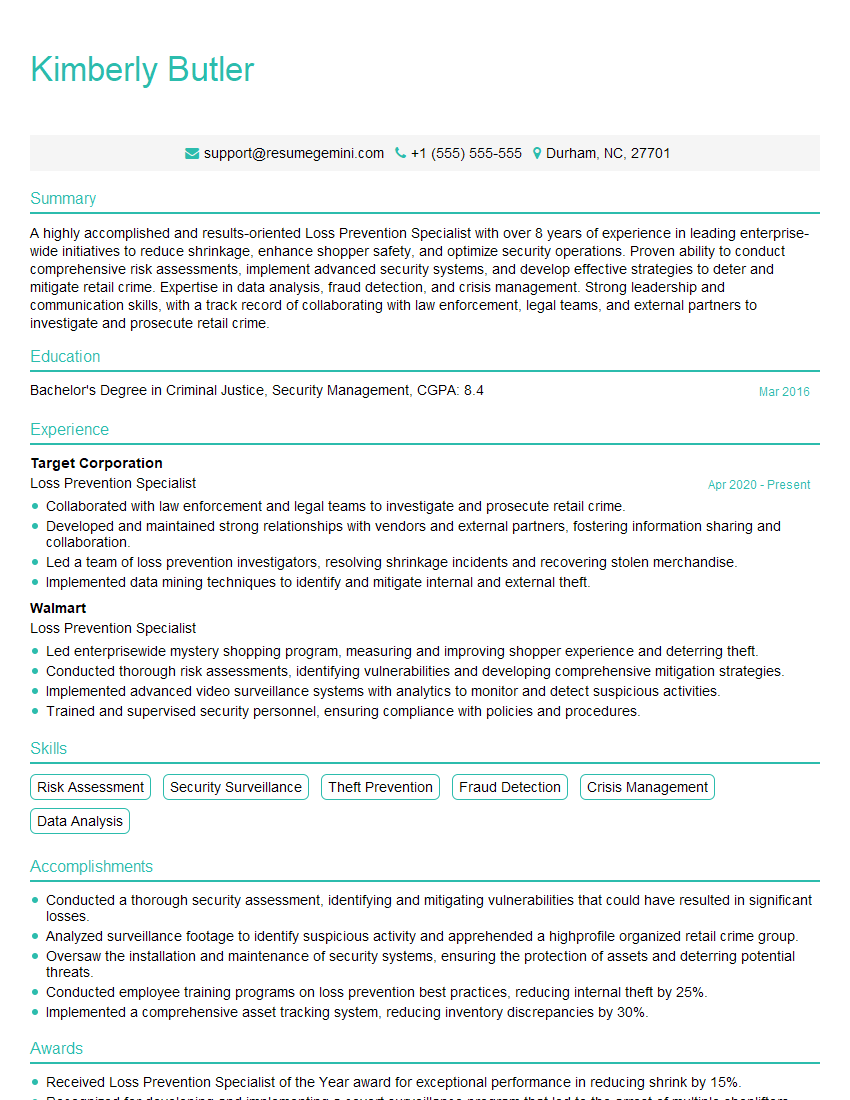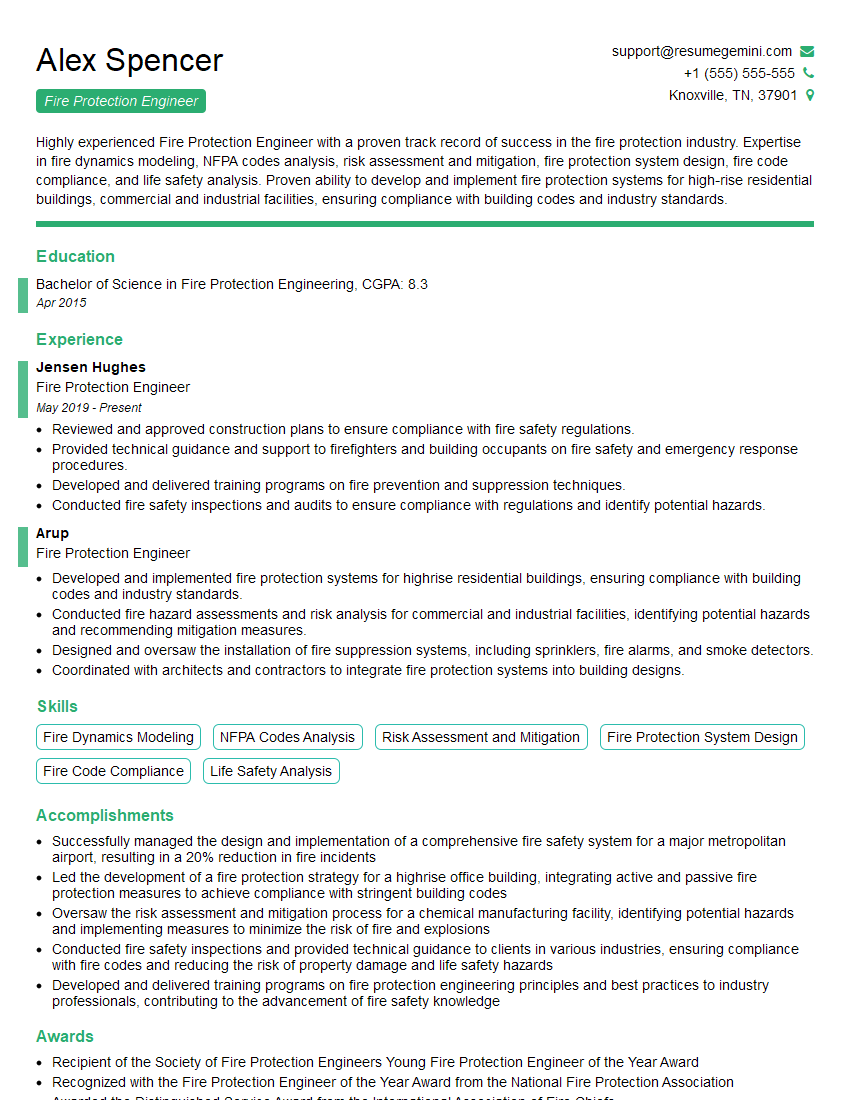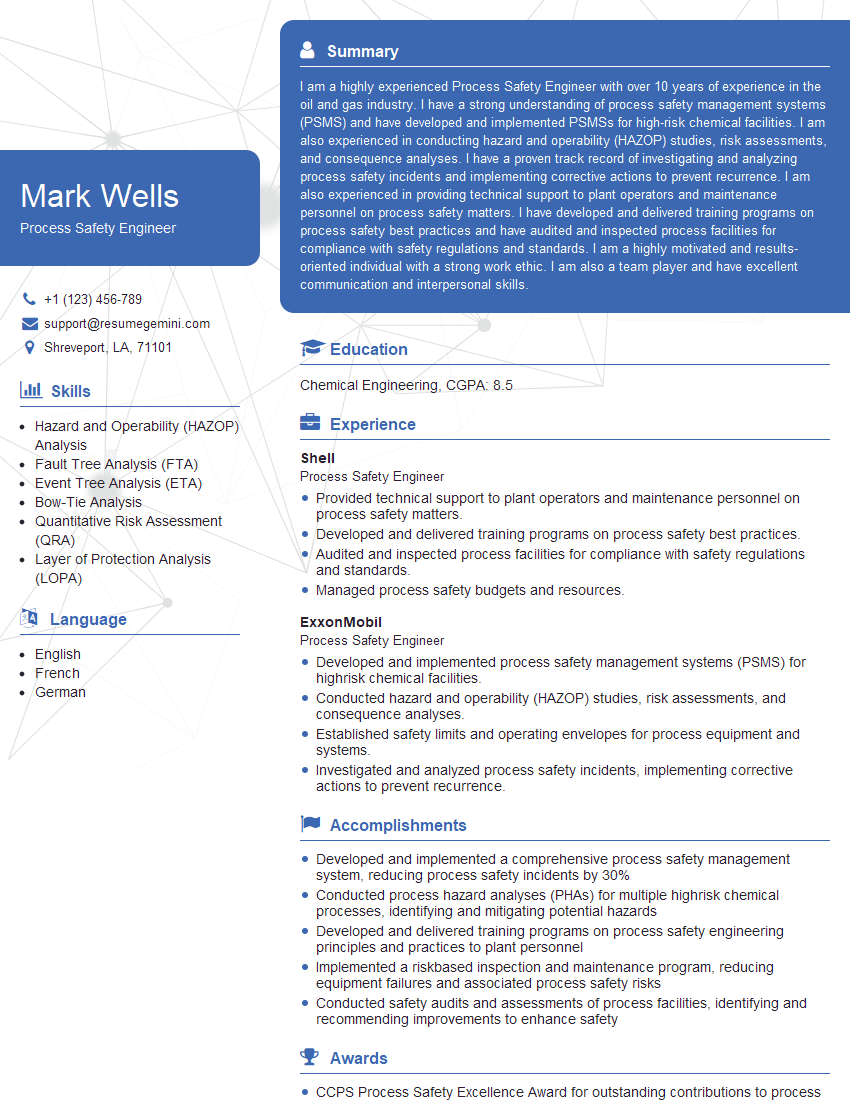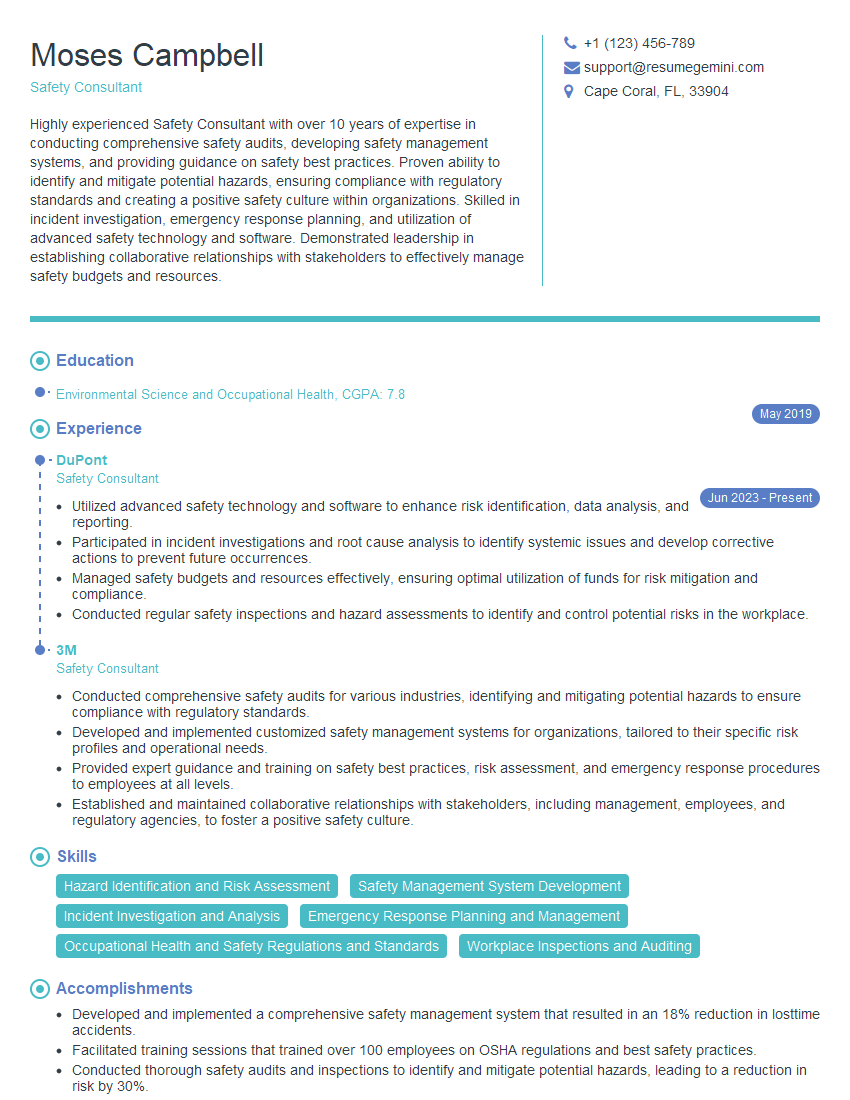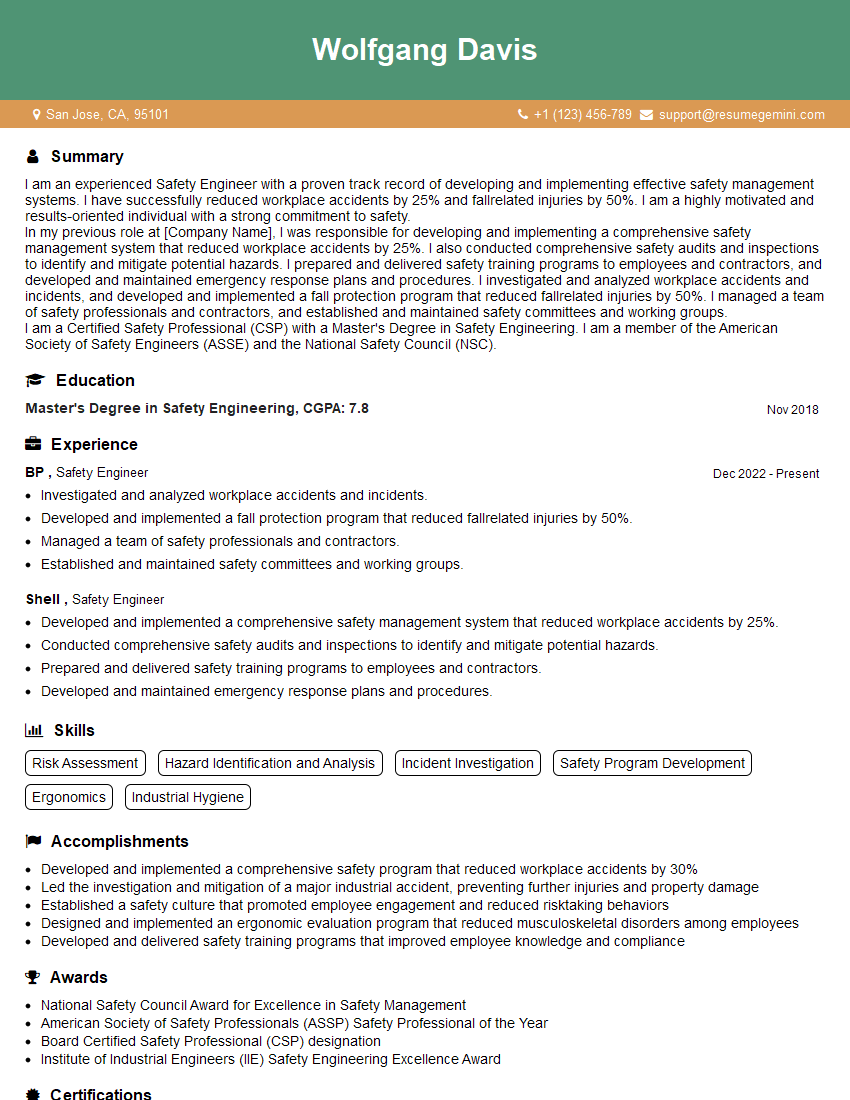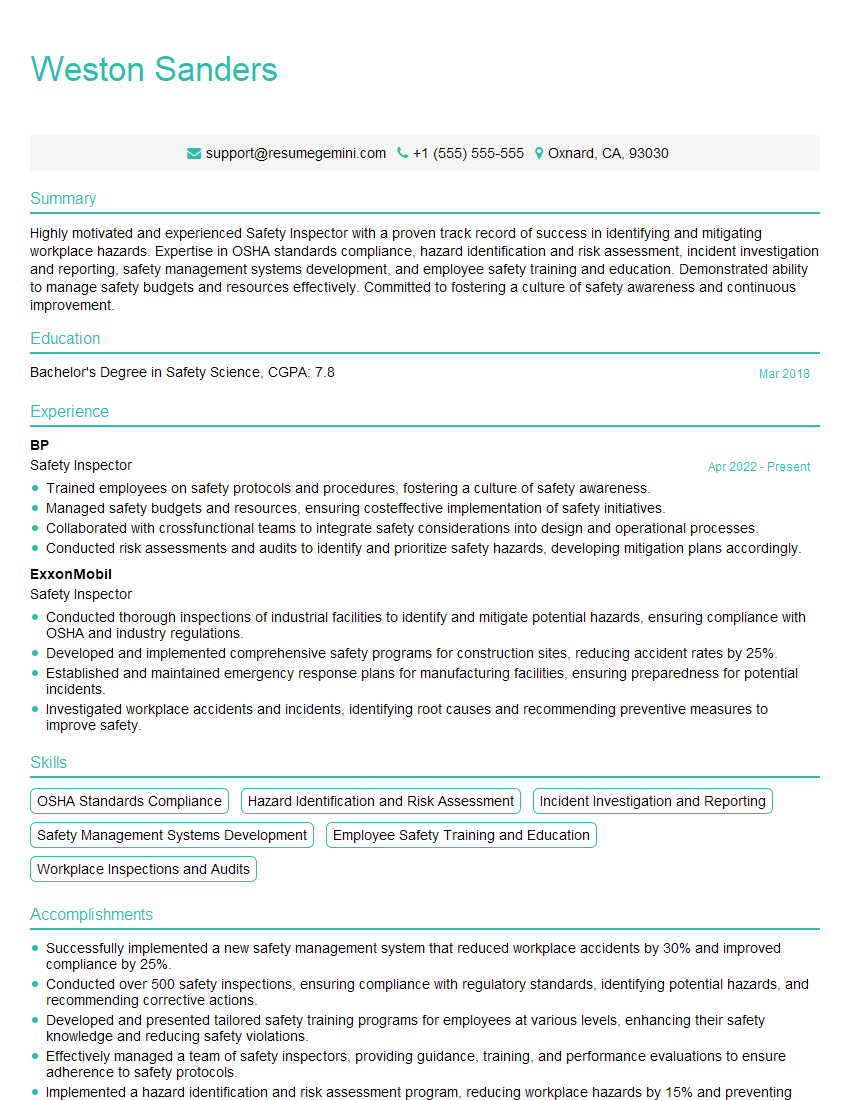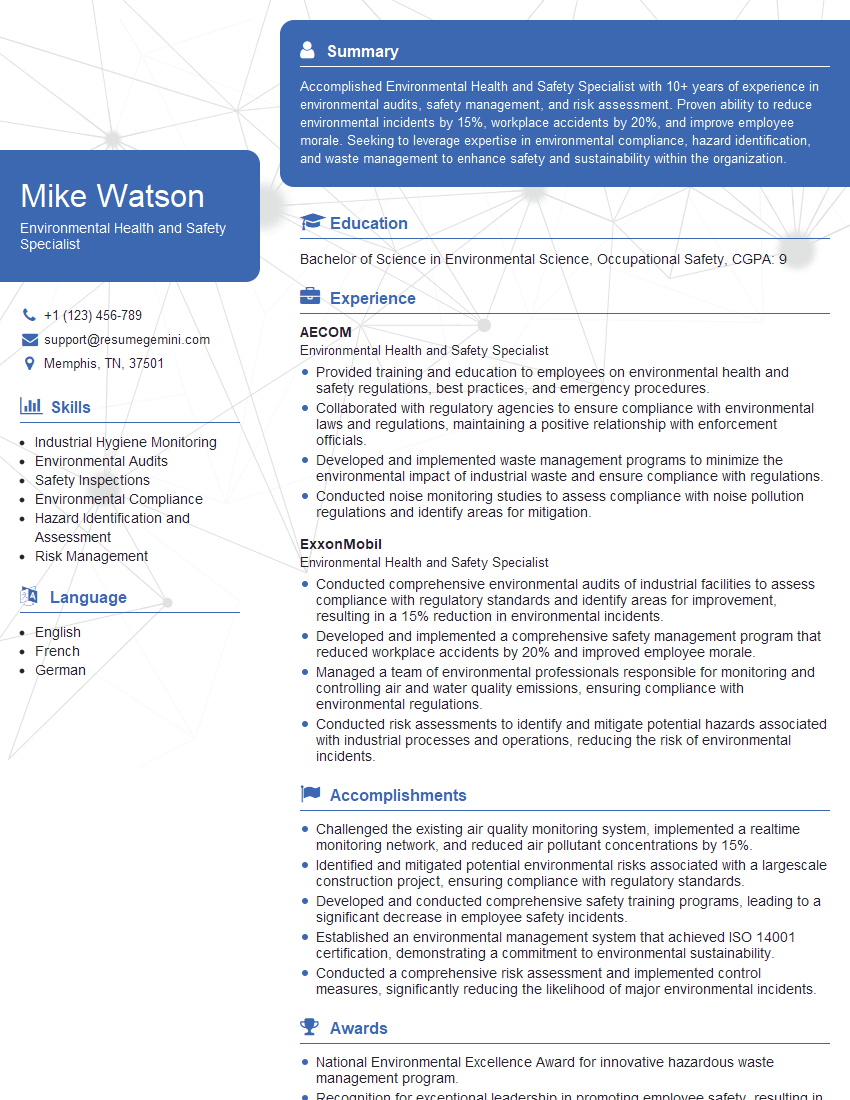Every successful interview starts with knowing what to expect. In this blog, we’ll take you through the top Oilfield Safety Regulations interview questions, breaking them down with expert tips to help you deliver impactful answers. Step into your next interview fully prepared and ready to succeed.
Questions Asked in Oilfield Safety Regulations Interview
Q 1. Describe your experience with OSHA regulations in the oil and gas industry.
My experience with OSHA regulations in the oil and gas industry spans over a decade, encompassing both direct application and auditing. I’ve been directly involved in ensuring compliance with OSHA’s Subpart H (Hazardous Energy Control), Subpart N (Welding and Cutting), and Subpart X (Confined Space Entry), among others. This included developing and implementing safety programs, conducting regular safety inspections, and providing training to personnel on hazard recognition and control. For example, I led a project to upgrade our lockout/tagout procedures, resulting in a 30% reduction in near-miss incidents related to hazardous energy. My audit experience includes reviewing safety data sheets (SDS), ensuring proper personal protective equipment (PPE) usage, and validating compliance with emergency response plans. I’m also familiar with the nuances of OSHA’s record-keeping requirements and have assisted companies in improving their injury and illness reporting processes. This ensures not just immediate safety, but also allows for a proactive approach to long-term safety improvement based on data analysis.
Q 2. Explain the hierarchy of controls in relation to oilfield safety.
The hierarchy of controls is a fundamental principle in oilfield safety. It prioritizes hazard elimination and reduction methods, moving from the most effective to the least. The order is as follows:
- Elimination: Physically removing the hazard. For example, replacing a hazardous chemical with a safer alternative. This is always the preferred method.
- Substitution: Replacing a hazardous process or material with a less hazardous one. A good example is using a less volatile solvent in a cleaning process.
- Engineering Controls: Implementing physical changes to the work environment to reduce the risk. This could involve installing machine guards, implementing improved ventilation systems to remove flammable gases, or using remote-controlled equipment to minimize worker exposure to hazardous areas.
- Administrative Controls: Establishing work practices and procedures to minimize risk. Examples include job safety analyses (JSAs), implementing permit-to-work systems, and providing specialized training to employees.
- Personal Protective Equipment (PPE): Providing workers with protective gear such as hard hats, safety glasses, respirators, and flame-resistant clothing. This is always the last line of defense and should never replace the other control measures.
Imagine a scenario involving a high-pressure gas line. Elimination might involve rerouting the line to avoid the work area altogether. If that’s not feasible, substitution might use a lower-pressure alternative. If neither are possible, engineering controls would focus on robust barriers and remote shutoff valves, followed by administrative controls like detailed procedures for working near the line. PPE, such as safety glasses and hearing protection, would be the final layer of protection.
Q 3. What are the key components of a comprehensive Job Safety Analysis (JSA)?
A comprehensive Job Safety Analysis (JSA) is a crucial document detailing the steps involved in a specific task, identifying potential hazards, and outlining the control measures to mitigate those risks. Key components include:
- Task Breakdown: A step-by-step description of the task, breaking it down into smaller, manageable segments.
- Hazard Identification: A list of all potential hazards associated with each step, including environmental, chemical, physical, and ergonomic hazards.
- Risk Assessment: Evaluating the likelihood and severity of each identified hazard. This often uses a matrix system to categorize risks (e.g., low, medium, high).
- Control Measures: Detailing the specific methods to control or mitigate each identified hazard. These should align with the hierarchy of controls discussed earlier.
- Personal Protective Equipment (PPE): Specifying the necessary PPE for each step of the task.
- Emergency Procedures: Outline the steps to take in case of an emergency or accident.
- Review and Updates: A process for regularly reviewing and updating the JSA to reflect changes in the work process or new safety information.
For example, a JSA for a wellhead repair would outline steps for shutting down the well, isolating the equipment, performing the repair, and then restarting the well, along with specific hazards and control measures for each step, such as the risk of high-pressure releases, and controls such as proper lock-out/tag-out procedures and use of specialized equipment.
Q 4. How would you conduct a risk assessment for a specific oilfield operation?
Conducting a risk assessment for a specific oilfield operation follows a structured approach. I would typically use a qualitative risk assessment method, such as a HAZOP (Hazard and Operability Study) or a What-If analysis. The process generally involves:
- Define the scope: Clearly identify the specific operation to be assessed, including its boundaries and objectives.
- Identify hazards: Brainstorm potential hazards, considering both normal and abnormal operating conditions. This often involves input from experienced personnel who are directly involved in the operation.
- Analyze risks: Assess the likelihood and severity of each identified hazard. This might involve using a risk matrix, assigning numerical values to the likelihood and severity and combining them to determine the overall risk level. For example, a high-likelihood, high-severity hazard would warrant immediate attention and rigorous control measures.
- Evaluate existing controls: Assess the effectiveness of any existing control measures in mitigating the identified hazards. Are they adequate, or are there gaps?
- Recommend control measures: Recommend additional control measures where necessary, prioritizing those that align with the hierarchy of controls. This may involve engineering controls, administrative controls, or PPE.
- Document the assessment: Create a comprehensive report documenting the entire process, including identified hazards, risk levels, control measures, and recommendations. This report will serve as a reference for ongoing safety management.
Consider a fracturing operation. A risk assessment would cover hazards like well control issues, chemical handling, and heavy equipment operation. The assessment would then detail measures to control each hazard—like using proper wellhead pressure monitoring, safety procedures for chemical handling and appropriate training, and ensuring regular maintenance on heavy equipment and proper operator training.
Q 5. Describe your experience with incident investigation and reporting procedures.
My experience with incident investigation and reporting procedures includes leading investigations into various incidents ranging from minor injuries to significant environmental releases. Our process adheres to established best practices and regulatory requirements. A typical investigation involves:
- Immediate Response: Securing the scene, ensuring the safety of personnel, and providing first aid if necessary.
- Fact-Finding: Gathering information through witness statements, reviewing documentation (e.g., permits, JSAs, training records), examining physical evidence, and analyzing data.
- Root Cause Analysis: Identifying the underlying causes of the incident, going beyond the immediate events to uncover the contributing factors. Techniques such as the “5 Whys” analysis are often used.
- Corrective Actions: Developing and implementing corrective actions to prevent similar incidents from occurring in the future. This might involve procedural changes, equipment modifications, or enhanced training.
- Reporting: Documenting the entire investigation process, including findings and corrective actions, in a comprehensive report. This is often submitted to regulatory agencies as required.
In one instance, we investigated a minor spill of drilling mud. Our investigation revealed inadequate training on spill response procedures and deficiencies in the storage and handling of drilling mud. Corrective actions included additional training, revised procedures, and improved containment systems, effectively preventing future occurrences.
Q 6. What are the common hazards associated with well control operations?
Well control operations present a unique set of hazards, many of which are potentially catastrophic. Common hazards include:
- High-pressure releases: Uncontrolled release of high-pressure fluids (oil, gas, water) can cause serious injuries, equipment damage, and environmental pollution.
- Wellbore instability: Sudden changes in wellbore conditions can lead to kicks (influx of formation fluids into the wellbore), blowouts, and other critical events.
- Hydrogen sulfide (H2S) exposure: H2S is a toxic and flammable gas often encountered in oil and gas operations. Exposure can lead to serious health consequences, even death.
- Fire and explosion: Flammable gases and liquids pose a significant fire and explosion risk, especially in confined spaces.
- Equipment failures: Failures of critical equipment, such as BOPs (Blowout Preventers), can lead to uncontrolled well discharges.
- Falls from height: Working at heights is common in oilfield operations, presenting a significant risk of falls.
Mitigation of these hazards relies heavily on rigorous well control procedures, emergency response planning, regular equipment inspections and maintenance, proper training for personnel, and effective safety management systems.
Q 7. Explain the purpose and application of a Permit-to-Work system.
A Permit-to-Work (PTW) system is a formal system used to control potentially hazardous work. It ensures that necessary precautions are in place before commencing high-risk tasks. The purpose is to prevent incidents by requiring a documented authorization process involving a series of checks and approvals. The application of a PTW system typically involves:
- Permit Application: A detailed application outlining the work to be performed, identifying potential hazards, and specifying the necessary control measures.
- Permit Issuance: An authorized person reviews the application and approves the permit, only after confirming that all necessary precautions are in place. This typically includes the completion of a pre-job safety briefing.
- Work Execution: The work is carried out according to the specified procedures and control measures. Regular supervision is usually required.
- Permit Closure: Once the work is completed, the permit is formally closed, signifying that the hazardous work has been concluded safely.
For instance, a PTW would be required before working on a high-pressure pipeline. The permit would outline all necessary isolation procedures, lockout/tagout procedures, and other safety measures. Without the proper approvals outlined in the Permit-to-Work system, work cannot proceed, thereby mitigating the potential for a serious incident.
Q 8. How do you ensure compliance with environmental regulations in oilfield operations?
Ensuring compliance with environmental regulations in oilfield operations is paramount. It involves a multi-faceted approach focusing on prevention, monitoring, and remediation. This begins with a thorough understanding of applicable laws and regulations, such as those from the EPA (Environmental Protection Agency) in the US or equivalent agencies in other countries. These regulations cover aspects like air emissions (methane, VOCs), wastewater discharge, and waste management (drilling muds, cuttings).
- Prevention: We utilize best practices like employing leak detection and repair (LDAR) programs, implementing advanced pollution control technologies (e.g., vapor recovery units), and using environmentally friendly drilling fluids.
- Monitoring: Regular environmental monitoring is crucial, including air and water quality testing, soil sampling, and noise level measurements. This data is meticulously documented and reported to regulatory bodies. We use sophisticated monitoring equipment and regularly calibrate instruments to ensure data accuracy.
- Remediation: In the event of a spill or other environmental incident, a swift and effective response plan is activated. This includes containing the spill, removing contaminated soil, and restoring the affected area. Documentation of the remediation process, including actions taken and results achieved, is essential.
For example, in one project, we successfully implemented a new wastewater treatment system that reduced our discharge of total suspended solids by 40%, exceeding regulatory requirements and minimizing environmental impact.
Q 9. Describe your understanding of emergency response plans and procedures.
Emergency response plans and procedures are the lifeblood of oilfield safety. A well-structured plan details actions to be taken in various emergency scenarios, including well control incidents, fires, spills, and medical emergencies. The plan should be readily accessible to all personnel, regularly practiced through drills, and updated to reflect changes in operations or regulations.
- Roles and Responsibilities: Clearly defined roles and responsibilities for each team member during an emergency are crucial. This ensures a coordinated response and avoids confusion during stressful situations.
- Communication Protocols: Efficient communication channels are vital. This includes emergency contact lists, designated communication frequencies (radio, satellite phones), and assembly points.
- Emergency Equipment: The availability and location of crucial equipment such as fire extinguishers, spill response kits, first-aid supplies, and emergency shut-off valves must be known to everyone. Regular inspections and maintenance ensure their readiness.
- Evacuation Procedures: Detailed evacuation plans for different scenarios (e.g., fire, hazardous material release) are critical, including designated escape routes and assembly points. These plans should be tested through regular drills and simulations.
We conduct regular emergency response drills, simulating various scenarios to ensure personnel are familiar with their roles and the procedures. These exercises help identify areas for improvement and enhance the effectiveness of our plan.
Q 10. Explain the importance of lockout/tagout procedures in preventing accidents.
Lockout/Tagout (LOTO) procedures are fundamental to preventing accidents involving hazardous energy sources. LOTO ensures that equipment is safely shut down and isolated before any maintenance or repair work is performed. This prevents accidental energization or release of hazardous energy, which can lead to serious injuries or fatalities.
- Procedure Steps: LOTO involves a standardized sequence of steps: Identify energy sources, isolate them, lock and tag equipment, verify the absence of energy, and then remove the locks and tags only after work is complete and energy sources are verified to be inactive.
- Training: Comprehensive training is crucial to ensuring personnel understand and follow LOTO procedures correctly. This training should be documented and regularly refreshed.
- Documentation: Maintaining accurate records of LOTO procedures is essential. This includes documenting each step, the individuals involved, and the time spent on the task.
- Enforcement: Stringent enforcement of LOTO procedures is crucial. Management’s commitment to safety is vital for compliance.
For example, before performing maintenance on a pump, the LOTO procedure requires isolating the power supply, locking out the breaker, tagging it, and verifying the absence of power before starting work. Only after completing the work and verifying the power is still off can the lock and tag be removed. Failure to follow these procedures can result in a catastrophic accident.
Q 11. How do you manage safety training programs for oilfield personnel?
Effective safety training programs are essential for a safe and productive work environment. Our approach emphasizes a multi-tiered system that targets specific needs and risk levels.
- Needs Assessment: We conduct thorough needs assessments to identify the specific training requirements for different job roles and tasks. This allows us to tailor training to address specific hazards and risks.
- Training Modules: We design and deliver comprehensive training modules covering various aspects of safety, including hazard identification, risk assessment, emergency response, LOTO procedures, and specific job-related hazards.
- Delivery Methods: We employ a variety of training methods, including classroom instruction, online modules, hands-on simulations, and on-the-job training, catering to different learning styles.
- Competency Assessments: We employ competency assessments – including both written and practical tests – to ensure that individuals have successfully grasped the knowledge and skills imparted during training. Continuous monitoring and feedback are critical.
- Regular Refresher Training: Regular refresher training ensures knowledge remains current and updated. This helps prevent complacency and reinforces safe work practices.
For instance, new hires receive extensive training in basic safety principles and oilfield-specific hazards before starting any field operations. Experienced personnel are regularly updated on new technologies and best practices through refresher courses and workshops.
Q 12. Describe your experience with confined space entry procedures.
Confined space entry procedures are critical due to the inherent dangers associated with working in enclosed areas with limited entry and exit. These spaces may contain hazardous atmospheres (lack of oxygen, presence of toxic gases), limited visibility, and potential for entrapment. Our procedures meticulously adhere to best practices and regulatory standards.
- Permit-Required Confined Space Entry: A permit-to-work system is crucial. The permit outlines the hazards, control measures, necessary equipment, and personnel responsible for the entry.
- Atmospheric Monitoring: Before any entry, atmospheric monitoring is mandatory using calibrated gas detection instruments to ensure a safe atmosphere. Continuous monitoring during entry is often required.
- Ventilation: Adequate ventilation is essential to remove or dilute any hazardous substances. Methods like forced ventilation might be necessary.
- Rescue Plan: A detailed rescue plan must be in place, including trained personnel and appropriate rescue equipment like harnesses and retrieval systems.
- Personal Protective Equipment (PPE): Appropriate PPE, including respirators, safety harnesses, and protective clothing, must be used by all personnel involved.
For example, before entering a tank for cleaning, a permit-to-work is issued only after atmospheric testing shows safe levels of oxygen and the absence of toxic gases. A standby attendant is present at all times to monitor conditions and assist in case of emergency.
Q 13. What are your strategies for improving safety culture within an oilfield team?
Improving safety culture is a continuous process, not a one-time project. It requires leadership commitment, employee engagement, and a proactive approach. Our strategies focus on creating a positive environment where safety is everyone’s responsibility.
- Leadership Commitment: Management must lead by example, demonstrating a strong commitment to safety through active participation in safety initiatives and reinforcement of safety rules.
- Employee Involvement: Employees must be actively involved in the safety process, from hazard identification to contributing to the development of safety procedures. Encouraging reporting of near misses without fear of reprisal is key.
- Communication and Feedback: Open and transparent communication is essential. Regular safety meetings, toolbox talks, and feedback mechanisms allow employees to voice concerns and contribute ideas for improvement.
- Recognition and Reward: Recognizing and rewarding safe behavior is crucial to reinforcing positive safety culture. This can include awards, certificates, and verbal acknowledgment of safe work practices.
- Continuous Improvement: Safety is a journey, not a destination. Regular review and improvement of safety procedures and training programs are vital. Analysis of accidents and near misses should guide improvements.
For instance, we implemented a suggestion box system to encourage employees to share ideas for improving safety procedures. The most impactful suggestions are implemented and the employee is recognized for their contribution.
Q 14. Explain your understanding of hazardous materials handling and transportation.
Hazardous materials handling and transportation require strict adherence to regulations and safety protocols to prevent accidents and protect the environment. This involves careful planning, training, and implementation of stringent procedures.
- Identification and Classification: Proper identification and classification of hazardous materials according to Globally Harmonized System of Classification and Labelling of Chemicals (GHS) is fundamental. This ensures proper handling, storage, and transportation procedures are followed.
- Storage and Handling: Hazardous materials should be stored in designated areas with appropriate containment and labeling. Safe handling procedures must be meticulously followed, with personnel properly trained and equipped with necessary PPE.
- Transportation: Transportation of hazardous materials requires compliance with regulations like those specified by the Department of Transportation (DOT) in the U.S. or equivalent agencies elsewhere. This includes proper packaging, labeling, and documentation. Drivers must have specific training and certifications.
- Emergency Response: Emergency response plans should address potential incidents during transportation, including spills or leaks. This includes having contingency plans, appropriate equipment, and trained personnel.
- Documentation: Maintaining meticulous records of handling, storage, and transportation activities is essential for compliance and traceability. This includes shipping manifests, safety data sheets (SDS), and other relevant documents.
For example, the transportation of drilling muds requires specialized tankers with proper containment measures, and drivers need to have Hazardous Materials Endorsements on their driving licenses. All transport must adhere to the DOT regulations, ensuring safe and compliant transportation.
Q 15. How would you handle a safety violation by a fellow employee?
Witnessing a safety violation by a colleague requires a measured and professional response, prioritizing safety and employee well-being. My approach follows a hierarchical process. First, I’d assess the severity of the violation. A minor infraction, like not wearing safety glasses for a low-risk task, might warrant a friendly reminder and a discussion about the importance of adherence to regulations. I would emphasize the potential consequences, not to reprimand, but to foster a shared understanding of safety.
However, for serious violations, such as bypassing a safety lockout procedure or disregarding a hazard warning, immediate action is crucial. I would first intervene to halt the unsafe activity, ensuring the immediate safety of everyone involved. Then, I would report the incident to my supervisor, providing a detailed account of what I observed, including the time, location, individuals involved, and the specific violation. The goal is not to ‘tattle’ but to ensure a safe working environment. Following the company’s reporting procedure is paramount. Depending on company policy and the severity, this might involve a formal incident report with supporting documentation and photographic evidence. Finally, I’d follow up to ensure corrective actions are taken and that the employee receives the necessary training or counseling to prevent future incidents.
For example, once I witnessed a worker failing to use a designated lifting device for heavy equipment. I immediately stopped the task, explained the risk of back injury, and reported it to my supervisor. We then organized refresher training for all employees on proper lifting techniques and equipment use.
Career Expert Tips:
- Ace those interviews! Prepare effectively by reviewing the Top 50 Most Common Interview Questions on ResumeGemini.
- Navigate your job search with confidence! Explore a wide range of Career Tips on ResumeGemini. Learn about common challenges and recommendations to overcome them.
- Craft the perfect resume! Master the Art of Resume Writing with ResumeGemini’s guide. Showcase your unique qualifications and achievements effectively.
- Don’t miss out on holiday savings! Build your dream resume with ResumeGemini’s ATS optimized templates.
Q 16. Describe your experience using safety management systems (SMS).
I have extensive experience working with Safety Management Systems (SMS), particularly within the BOWTIE (Bow-Tie Analysis) framework. SMS isn’t just a set of rules; it’s a proactive, holistic approach to managing risk. My experience encompasses all aspects, from hazard identification and risk assessment through to control implementation and monitoring.
In my previous role, we utilized a software-based SMS that allowed for the systematic recording and tracking of hazards, risk assessments, corrective actions, and training records. This software facilitated clear communication and accountability across all levels of the organization. For instance, using the Bow-Tie method, we analyzed potential major accident hazards (e.g., well blowout). We identified the initiating events (e.g., equipment failure), the preventive and mitigating barriers (e.g., regular maintenance and emergency shutdown systems), and the consequences if these barriers failed (e.g., environmental damage, injury).
The SMS also helped us develop and implement detailed emergency response plans, which were regularly drilled and updated. This included developing pre-planned emergency response procedures for various scenarios, including well control, fire, and evacuation procedures and ensuring adequate training and emergency equipment are readily available. Regular audits and reviews of the SMS helped ensure its effectiveness and continual improvement.
Q 17. What are your methods for identifying and mitigating human factors risks?
Identifying and mitigating human factors risks is crucial in the oilfield. My approach involves a multi-faceted strategy. First, I leverage tools like Job Safety Analyses (JSAs) and HAZOP (Hazard and Operability) studies to systematically identify potential human errors in tasks and processes. These analyses often uncover the underlying human factors, such as fatigue, complacency, stress, poor communication, or inadequate training.
Next, I utilize various mitigation strategies tailored to the identified risks. This could involve: implementing improved procedures, providing enhanced training, using technology to aid in task completion (e.g., automated systems reducing manual intervention), designing ergonomically sound workspaces, and implementing fatigue management programs, which involve better scheduling practices and rest periods.
For example, a JSA of a well-testing operation might reveal that rushing to meet production targets increases the risk of human error. Our mitigation strategy might involve a focus on team communication, clear task allocation, proper time management techniques, and increased supervision during critical phases of the operation to counter the negative impact of time pressure.
Q 18. How familiar are you with various types of personal protective equipment (PPE)?
My familiarity with personal protective equipment (PPE) is extensive. I’m proficient in identifying the appropriate PPE for various tasks and hazards encountered in the oilfield. This includes:
- Head protection: Hard hats, bump caps.
- Eye and face protection: Safety glasses, goggles, face shields.
- Respiratory protection: Respirators (various types), dust masks.
- Hearing protection: Earplugs, earmuffs.
- Hand protection: Gloves (various types, including cut-resistant, chemical-resistant, and heat-resistant).
- Foot protection: Safety boots, steel-toe boots.
- Body protection: Flame-resistant clothing (FRC), high-visibility clothing, fall protection harnesses.
Beyond simply knowing the types, I understand the proper selection, inspection, maintenance, and limitations of each piece of PPE. I’m also knowledgeable about regulatory requirements and standards (e.g., OSHA, API) concerning PPE use and training.
Q 19. Explain your understanding of fire and explosion prevention measures in oilfields.
Fire and explosion prevention in oilfields necessitates a multi-layered approach, combining engineering controls, administrative controls, and emergency preparedness. Engineering controls focus on minimizing ignition sources and containing flammable materials. This involves proper electrical installations, grounding systems, using explosion-proof equipment, implementing effective ventilation systems in confined spaces, and employing fire suppression systems such as deluge systems and firewalls.
Administrative controls include rigorous procedures for handling flammable materials, hot work permits (requiring detailed risk assessments and safety precautions before commencing hot work such as welding), regular inspections of equipment and facilities, and comprehensive training programs for all personnel on fire prevention and response. Emergency preparedness includes developing detailed emergency response plans, conducting regular drills, ensuring easy access to firefighting equipment, and implementing clear communication protocols during emergencies.
For example, we’d ensure all electrical equipment is properly grounded and regularly inspected, and that flammable materials are stored in designated areas away from ignition sources. Hot work permits would ensure that proper precautions, like fire watch and the use of fire blankets, are taken before starting activities involving open flames.
Q 20. Describe your experience with the development and implementation of safety policies.
I’ve been involved in the development and implementation of numerous safety policies throughout my career. This involves a collaborative process, starting with a thorough hazard identification and risk assessment process. We would utilize various methods such as JSA, HAZOP, and what-if analyses to identify potential hazards. Based on these assessments, we would develop specific safety policies addressing those hazards, tailored to the unique aspects of the operation. These policies would address everything from specific work procedures to emergency response protocols.
The policies are then clearly documented, communicated, and made readily accessible to all employees. We’d also integrate the policies into training programs, ensuring that all personnel understand and can apply them effectively. Furthermore, regular audits and reviews are conducted to check for compliance and to identify areas for improvement. The process isn’t static; we regularly update and revise policies based on incident investigations, new technologies, and regulatory changes.
In a previous project, we developed a new safety policy addressing confined space entry. This involved creating detailed procedures for pre-entry checks, atmospheric monitoring, rescue plans, and necessary PPE. The policy’s effectiveness was evaluated through regular audits, and training programs ensured that all workers were capable of safe confined space entry.
Q 21. How would you communicate safety information effectively to a diverse workforce?
Communicating safety information effectively to a diverse workforce necessitates a multi-pronged approach that considers language barriers, literacy levels, and cultural differences. I leverage various methods to ensure clear understanding. First, I ensure that all safety information is translated into the primary languages spoken by our workforce. We also use visual aids, such as pictures, diagrams, and videos to aid comprehension, particularly for individuals with low literacy levels.
Secondly, I utilize interactive training methods, such as hands-on demonstrations, role-playing, and group discussions. This allows for active participation and makes the learning experience more engaging. Regular toolbox talks, delivered in a clear and concise manner, provide updates on safety procedures, highlight recent incidents, and facilitate open discussions about safety concerns. We ensure safety information is accessible in various formats, including written materials, online modules, and audio recordings.
For example, when implementing a new safety procedure, we would use a multi-lingual video demonstrating the correct procedure, followed by a hands-on practice session, where workers could ask questions and receive immediate feedback. We always ensure workers feel comfortable voicing their concerns and suggestions, fostering a culture of open communication and mutual respect.
Q 22. Explain your knowledge of emergency shutdown systems and procedures.
Emergency Shutdown Systems (ESD) are crucial for preventing catastrophic events in oilfield operations. They’re designed to automatically or manually shut down equipment in hazardous situations, minimizing damage and preventing injuries. My knowledge encompasses both the technical aspects and the procedural elements.
Technical Aspects: I understand the various types of ESD systems, including those triggered by pressure, temperature, flow rate, or gas detection. I’m familiar with their components – sensors, logic solvers, actuators (valves, pumps), and their interlocks. I know the importance of redundancy and fail-safe mechanisms to ensure reliable operation even in case of component failure. For example, a critical valve might have dual actuators, each with its own power supply and control system, to guarantee a shutdown even if one fails.
Procedural Elements: This includes understanding the pre-startup safety checks, regular testing and maintenance schedules, and emergency response plans. ESD system testing is not a simple ‘on/off’ switch; it involves simulating various failure scenarios to ensure the system reacts appropriately. This also involves rigorous documentation, including maintenance logs, test results, and training records. Finally, I understand the importance of regular operator training in the correct procedures for both initiating and responding to an ESD system activation, including understanding the post-ESD procedures.
Example: In a previous role, I oversaw the implementation of a new ESD system for a high-pressure drilling operation. We simulated multiple failure scenarios, including power outages and sensor malfunctions, ensuring the system consistently and reliably shut down the well within acceptable timeframes.
Q 23. What are the key elements of a successful safety audit?
A successful safety audit is a systematic evaluation of an organization’s safety management system, identifying gaps and opportunities for improvement. Key elements include:
- Pre-audit planning: Defining the scope, objectives, and methodology, including a detailed checklist based on relevant regulations and industry best practices.
- Documented procedures and evidence: Reviewing safety policies, procedures, training records, risk assessments, and inspection reports. The presence of documentation isn’t enough; its effectiveness and implementation must be verified.
- On-site observations: Conducting physical inspections of facilities, equipment, and work practices to assess compliance with safety standards and procedures. This involves direct observation of worker behaviors and operating procedures.
- Interviews and discussions: Engaging with workers at all levels to gather their perspectives on safety culture, procedures, and hazards. This helps uncover latent safety issues not evident in documentation.
- Data analysis: Analyzing safety performance data (incident rates, near misses, etc.) to identify trends and areas needing attention. This can include lagging indicators (historical data on injuries) and leading indicators (proactive measures, such as near misses).
- Reporting and follow-up: Preparing a comprehensive report that clearly outlines findings, recommendations, and corrective actions, ensuring timely follow-up to verify the implementation of corrective actions.
Example: I once led a safety audit for a pipeline company, resulting in the identification of deficiencies in their emergency response plan and pipeline integrity management program. Our recommendations, which were fully implemented, led to significant improvements in their safety performance.
Q 24. Describe your experience with regulatory inspections and audits.
I have extensive experience with regulatory inspections and audits conducted by agencies such as OSHA (Occupational Safety and Health Administration) and other relevant state and federal entities. This includes preparing for audits, facilitating on-site inspections, addressing inspector inquiries, and implementing corrective actions based on audit findings.
The process begins with receiving notification of the audit and compiling all relevant documentation demonstrating compliance with regulations. This includes permits, training records, inspection reports, and safety management system documentation. During the on-site inspection, I actively cooperate with inspectors, answer their questions accurately and thoroughly, and provide access to requested information. I have a clear understanding of the regulatory requirements and am prepared to discuss the justification for any variations from standard procedures.
Following the audit, I analyze the findings, prioritize corrective actions, and implement these in a timely manner, often creating a detailed action plan with timelines and responsible parties. This includes updating procedures, improving training programs, or modifying equipment to address any identified deficiencies.
Example: During an OSHA inspection, a minor discrepancy was identified in our confined space entry procedures. I immediately addressed this by revising the procedure, providing additional training to personnel, and demonstrating the revised procedure to the inspector before their departure. This proactive response demonstrated our commitment to safety and resulted in a positive conclusion to the inspection.
Q 25. Explain how you ensure the effectiveness of safety training programs.
Ensuring the effectiveness of safety training programs relies on a multi-faceted approach. It begins with a needs assessment, identifying the specific safety hazards and knowledge gaps within the workforce.
Needs Assessment: This involves analyzing job tasks, risk assessments, incident reports, and interviewing employees to determine what training is needed. A well-designed training program should then target those specific needs.
Program Design: The program must be engaging and relevant, using a variety of methods such as classroom instruction, hands-on training, simulations, and e-learning modules. The use of interactive scenarios and real-world case studies is particularly helpful to improve knowledge retention.
Delivery and Assessment: Effective delivery includes using qualified instructors, providing adequate resources, and ensuring participants actively participate. Assessments, such as tests, practical demonstrations, and performance evaluations, are crucial to measure learning and identify areas needing further training.
Follow-up and Reinforcement: Training is not a one-time event. Regular reinforcement through job site observations, refresher courses, and updates on new regulations are critical to maintain proficiency and a strong safety culture. This can involve incorporating safety topics into regular toolbox talks or safety meetings.
Example: In a previous role, we implemented a comprehensive, hands-on training program for workers involved in hazardous material handling. The program, which included both classroom instruction and simulated scenarios, significantly reduced near-miss incidents related to hazardous material handling, showcasing a direct improvement thanks to proper training.
Q 26. How do you measure the success of safety initiatives?
Measuring the success of safety initiatives requires a balanced approach using both leading and lagging indicators.
Lagging Indicators: These measure the outcomes of safety efforts and include metrics such as:
- Total Recordable Incident Rate (TRIR): Measures the number of recordable injuries per 100 full-time employees.
- Lost Time Incident Rate (LTIR): Measures the number of lost-time injuries per 100 full-time employees.
- Days Away, Restricted, or Transferred (DART) Rate: Measures the number of workdays lost due to injuries per 100 full-time employees.
Leading Indicators: These predict future safety performance and include metrics such as:
- Number of safety observations and near misses reported: Indicates proactive identification of potential hazards.
- Employee safety training participation and scores: Shows the commitment to safety training and knowledge retention.
- Number of safety audits and inspections conducted: Demonstrates a proactive approach to risk management.
- Safety meeting attendance and participation: Shows engagement in safety discussions and initiatives.
By tracking both lagging and leading indicators, we gain a comprehensive understanding of safety performance, identify areas for improvement, and demonstrate the return on investment for safety initiatives. It’s critical to compare these measures against established benchmarks and industry averages to gauge effective progress.
Q 27. How do you stay current with changes in oilfield safety regulations?
Staying current with changes in oilfield safety regulations requires a proactive and multi-pronged approach.
Subscription to Regulatory Updates: I subscribe to newsletters and publications from regulatory bodies like OSHA and other relevant state and national agencies. This provides direct access to updates on new regulations, interpretations, and enforcement guidance.
Professional Organizations and Networking: Active participation in professional organizations such as the Society of Petroleum Engineers (SPE) and attendance at industry conferences and workshops keeps me informed about emerging safety issues and best practices. Networking with colleagues allows for the sharing of knowledge and insights.
Industry Publications and Journals: I regularly read industry publications and journals, which provide information on new technologies, safety innovations, and case studies of safety incidents. These often include discussions of regulatory changes and their impact.
Training Courses and Workshops: I participate in continuous professional development activities including specialized training courses and workshops focusing on recent regulatory updates and advancements in safety practices. This ensures my expertise is consistently up to date.
Online Resources: Utilizing reputable online resources for staying informed about regulatory changes and updates is essential. These often provide updated documents, legal guidance, and training resources related to safety in the oil and gas industry.
Q 28. Describe a time you had to make a difficult decision related to safety.
During a well intervention operation, I was faced with a situation where a crucial safety device was malfunctioning. The device, a crucial part of the well control system, displayed an intermittent fault. The initial assessment suggested it could be repaired within the day, but the risk of equipment failure during the ongoing operation was considerable.
The options were:
- Continue the operation with the faulty device: This involved significant risk, as failure could lead to a well blowout.
- Halt the operation and initiate a costly repair: This would result in considerable financial losses due to downtime and potential penalties for failing to meet project deadlines.
After careful consideration of the risks and consulting with the operations team and safety experts, I made the difficult decision to halt the operation and prioritize the repair of the safety device. This decision, although expensive in the short term, significantly mitigated the risk of a major incident, protecting personnel and the environment. A thorough investigation was conducted to determine the root cause of the malfunction, preventing similar incidents in the future. This decision underscored the importance of prioritizing safety over immediate financial gains. The subsequent repairs and investigation further reinforced our commitment to safety, and proved to be a valuable lesson for everyone involved.
Key Topics to Learn for Oilfield Safety Regulations Interview
- Hazard Identification and Risk Assessment: Understanding methods for identifying potential hazards (e.g., HIRA), conducting risk assessments, and implementing control measures to mitigate risks.
- Emergency Response Planning: Knowing procedures for various emergencies (fires, spills, well control incidents), including evacuation plans, communication protocols, and the roles and responsibilities of personnel.
- Personal Protective Equipment (PPE): Familiarity with different types of PPE, their proper use, limitations, and selection based on specific hazards. Practical application involves understanding selection criteria for different tasks and environments.
- Permit-to-Work Systems: Understanding the principles and practical application of permit-to-work systems, including authorizing, executing, and closing out permits. This includes understanding the importance of thorough risk assessments before commencing work.
- Well Control: Basic understanding of well control principles, equipment, and procedures. This should include theoretical knowledge of pressure control and practical awareness of potential well-related incidents.
- Safe Work Practices: Knowledge of general safety practices, such as lockout/tagout procedures, confined space entry, and working at heights. Practical application should cover scenarios and decision-making in these situations.
- Relevant Legislation and Regulations: Familiarity with key legislation and regulations governing oilfield safety in your specific region. This requires understanding the practical implications of these regulations on day-to-day operations.
- Incident Investigation and Reporting: Understanding the process of investigating incidents, identifying root causes, and implementing corrective actions to prevent recurrence. This includes knowing the importance of accurate and timely reporting.
Next Steps
Mastering Oilfield Safety Regulations is crucial for a successful and fulfilling career in this industry. A strong understanding of these regulations not only ensures a safe work environment but also demonstrates your commitment to responsible operations and enhances your professional credibility. To maximize your job prospects, create an ATS-friendly resume that effectively highlights your skills and experience. ResumeGemini is a trusted resource that can help you build a professional and impactful resume. Examples of resumes tailored to Oilfield Safety Regulations are available to guide you through this process.
Explore more articles
Users Rating of Our Blogs
Share Your Experience
We value your feedback! Please rate our content and share your thoughts (optional).
What Readers Say About Our Blog
good
